Software developers are always worrying about infrastructure issues and server maintenance, but now they can forget about all this administrative overhead. With serverless computing, their dreams about focusing entirely on writing code can finally come true.
Businesses are always looking for ways to streamline their operations and save costs at the same time. With serverless computing, they can run their applications more efficiently and shift their focus from managing underlying infrastructure to achieving business goals.
In this article, we discuss the basic principles of serverless computing, underscore the benefits of this technology, provide an overview of use cases for a serverless computing architecture. We also analyzed many of Apriorit’s serverless projects to figure out what to consider before adopting serverless computing for your business.
This article will be useful for business owners and project leaders who are looking for a way of streamlining their operations and improving app performance with the help of serverless computing.
Contents:
Introduction to serverless computing
Serverless computing is one of the modern cloud computing models. The term serverless computing is actually a misnomer. A serverless architecture uses servers, only the cloud provider is the one who maintains them instead of your developers or other business users.
Serverless computing has several alternative names: serverless architecture, event-based programming, or function as a service (FaaS), as it uses functions as the deployment unit. Serverless computing leverages the pay-as-you-go pricing model where you only pay for the resources you use. In addition, a serverless architecture ensures auto-scaling, allowing you to steadily provide your services to end users despite the increasing workload.
The main difference between serverless computing vs cloud computing is in control over the infrastructure. In cloud computing, users have more control over the infrastructure, while in serverless computing, infrastructure is managed by the provider, and the user only focuses on writing and deploying code.
A study by Global Market Insights Inc. found that the global market for serverless architecture is expected to grow by 25% annually from 2023 to 2032. By then, it could reach a value of $90 billion worldwide.
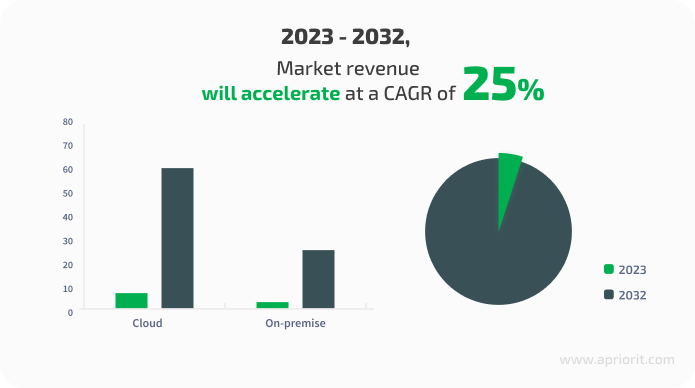
Whether you’re a developer looking for a way to optimize your code or a business owner seeking to streamline operations, you can implement elements of serverless functions in your operations. Here are some common tasks you can handle with serverless computing:
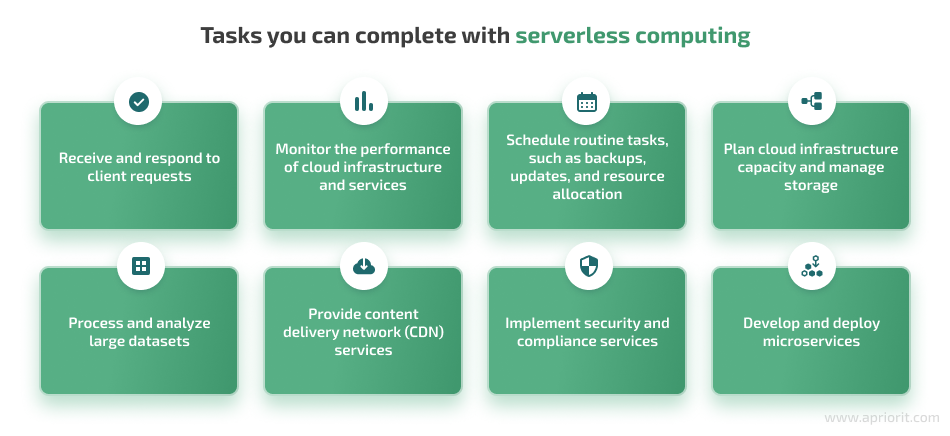
Thanks to all these capabilities, serverless computing is considered a cost-saving, resource-saving, and fault-tolerant approach to software development, all of which we explore in the next sections.
Serverless computing alternatives
There are several alternatives to serverless computing. You might look into other options depending on your business needs and goals. Here are the most popular choices when shifting to the cloud or building cloud-native applications:
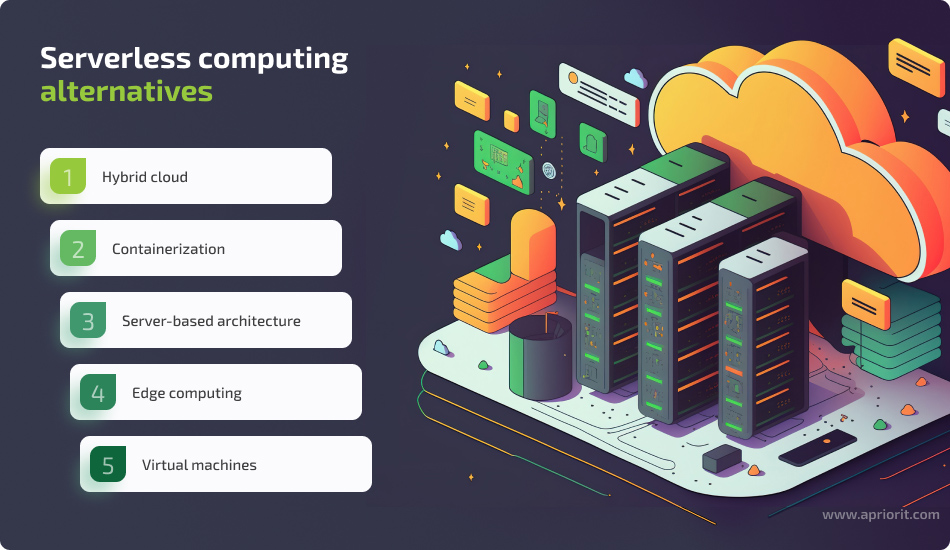
A hybrid cloud combines the benefits of both public and private clouds. A hybrid cloud provides more control over data privacy and security, as you can store sensitive data in your private cloud. This architecture also allows for workload allocation based on the type of data and processing requirements, leading to better cost management.
Containerization offers better control over underlying infrastructure and more flexibility in choosing the runtime environment in contrast to a serverless architecture. You can encapsulate your application in a container, making sure that it runs consistently across different environments.
A server-based architecture is better than serverless for cases when you need to integrate with legacy systems that can’t be migrated to serverless computing environments. It also provides a reliable environment that can be optimized for specific use cases even though a server-based architecture requires more management overhead.
Edge computing, compared to cloud computing, involves processing data near the source rather than in the cloud, which results in lower latency and improved performance for applications that require real-time processing. It’s more relevant in cases when there’s unreliable cloud connectivity, such as in remote locations.
Virtual machines offer a level of customization and optimization of performance and resource use that cannot be achieved with serverless computing. Virtual machines can be used for managing legacy applications that can’t be migrated to serverless computing environments.
Before exploring the benefits and use cases of serverless computing, we take a closer look at the serverless architecture so you can better understand how serverless computing works.
Main components of a serverless architecture
A serverless architecture depends on external frontend as a service (FaaS) and backend as a service (BaaS) providers, which run the application code in temporary containers.
A serverless architecture includes the following core components:
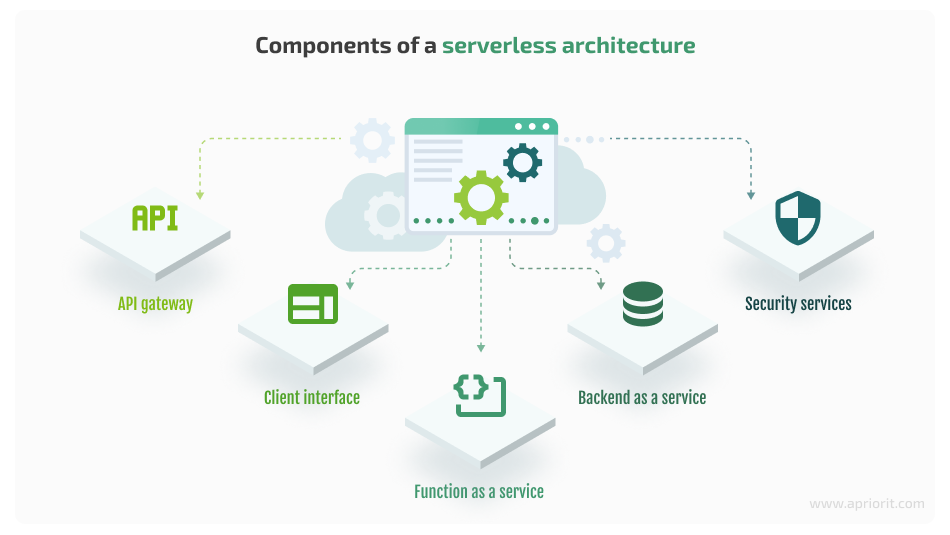
API gateway — This is a fully managed service that’s used to define, deploy, and maintain APIs. For API integrations, developers use standard HTTPS requests that connect their presentation tier with the functions they write on a serverless platform. Some serverless providers like Amazon offer their own API gateways.
Function as a service — This is a layer that executes the application code (business logic) through multi-protocol triggers. Function instances are provisioned on request in сompliance with associated configurations.
Backend as a service — This is a cloud computing model that serves as a cloud-based distributed database, reducing administrative overhead. BaaS features include cloud storage, push notifications, server code, user and file management, and many other backend services that have their own APIs so developers can easily integrate them into their applications.
Client interface — This is the user-facing portion of any serverless application. Usually, it is represented as a web or mobile application. With the help of APIs, the client interface can connect to the serverless backend. Functions are triggered depending on user input.
Security services — This is an additional layer of protection for a serverless application. Security services include identity and access management, encryption, monitoring, and threat detection. The main goal of this layer is to secure backend functions, APIs, and data storage.
Next, let’s talk about the reasons why businesses should go serverless.
6 reasons why businesses should embrace serverless computing
There are a lot of benefits of serverless architecture, including better application performance, multi-language support for developers, and reduced operational costs. Let’s take a look at the key reasons why businesses decide to go serverless.
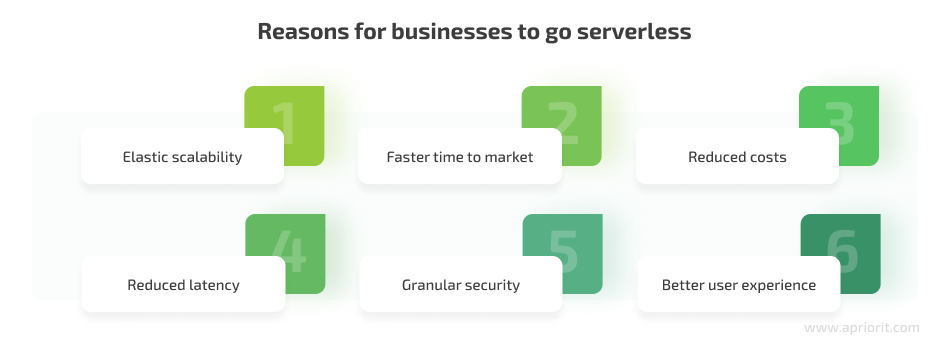
- Elastic scalability. A serverless architecture has the ability to scale up and down according to the application workload. You can achieve this by replicating functions, which are executed as they are requested in the serverless model. You no longer need to purchase additional infrastructure to handle unexpected growth and traffic spikes.
- Faster time to market. In the serverless model, you don’t need to think about workload intensity, resource distribution, scaling, and application deployment. You can delegate these issues to the hands of the cloud provider, allowing your developers to focus on other tasks.
- Reduced costs. Serverless computing allows you to use the pay-per-use model, paying only for those resources that you actually use at any given time.
- Reduced latency. By supporting content delivery networks and caching content closer to users, your applications have reduced latency and a faster response to end-user requests.
- Granular security. Your business will have a better security posture, as your developers can break down applications into smaller components. This introduces a granular approach to security, where each function can have its own security and access policies.
- Better user experience. As your applications now go through faster development cycles and serverless automation scaling, you can deploy new features and updates more frequently.
All of these advantages make serverless computing a popular choice for businesses looking for a cost-efficient development and execution model. Many major cloud providers offer their own serverless computing platforms for your convenience. In the next section, we take a look at serverless computing examples of major players in this market.
Popular serverless computing providers
Many organizations, including Apriorit, use serverless technology for their mission-critical software, which shows that businesses of all sizes and across many industries can benefit from adopting this technology. Currently, all tech giants provide their own serverless computing platforms:
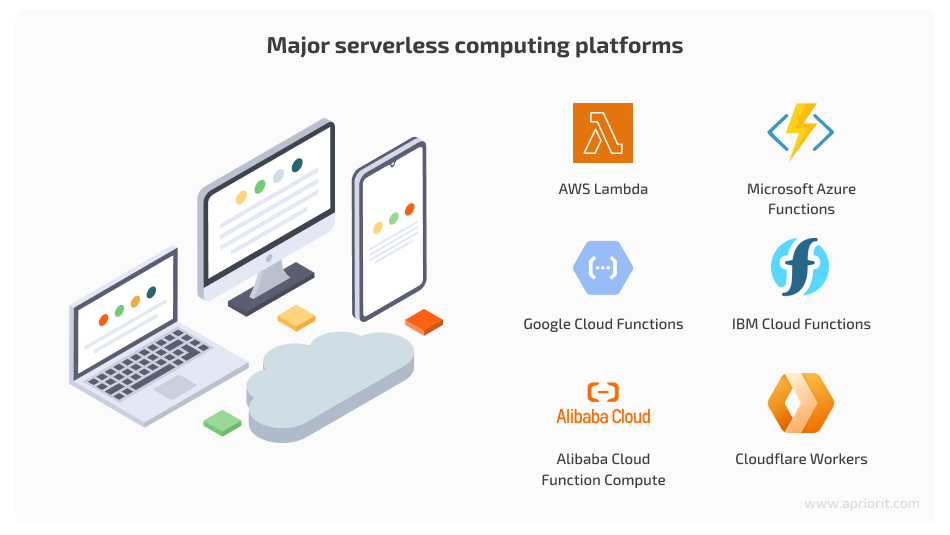
Amazon Web Services (AWS) Lambda supports a variety of programming languages including Java, Python, and Node.js. Lambda takes advantage of most AWS services and allows you to apply its functions as event handlers as well as to provide glue code when composing services.
Microsoft Azure Functions lets you write code for functions that process images, send emails, and maintain files that are executed on schedule or when needed. The platform provides HTTP webhooks, integration with Azure, and support for such programming languages as .NET, Go, Node.js, Python, PHP, and Java. The runtime code is open-source and is available on GitHub under the MIT License.
Google Cloud Functions is a serverless computing platform that provides basic FaaS functionality to run serverless functions written in Node.js. It offers development tools such as prediction APIs, translation APIs, and data storage.
IBM Cloud Functions is a FaaS platform for creating composite functions. It supports Node.js, Java, Swift, Python, and arbitrary binaries embedded in a Docker container. Cloud Function is based on OpenWhisk, which is available on GitHub under the Apache open-source license.
Alibaba Cloud Function Compute is a serverless computing platform provided by Alibaba Cloud, a leading cloud provider in China. Function Compute allows you to run code in response to events, such as HTTP requests, object storage changes, and message queue events, without having to manage servers or infrastructure.
Cloudflare Workers is a serverless computing platform provided by Cloudflare, a global content delivery network (CDN) and cybersecurity company. It allows you to run code at the edge of the network, in data centers located around the world. With Workers, developers can write code in JavaScript, Rust, or C++ and deploy it to the edge without having to manage servers or infrastructure.
It has been almost a decade since serverless technology gained wide recognition after Amazon launched AWS Lambda in 2014. During this time, many industries have adopted serverless architecture to streamline their processes. There are also many use cases where FaaS can serve as a perfect choice. Let’s explore these in detail.
Use cases for serverless computing
Serverless computing has been a game changer for many industries. This technology can be used for a wide range of tasks that help to build and deploy applications faster and more cost-effectively than ever before.
FaaS technology works best when it’s used for short-lived tasks and managing irregular traffic. For example, trigger-based tasks rely on backend work that can be managed through serverless computing. Asynchronous processing is also an ideal candidate for using FaaS. In this case, serverless functions are responsible for behind-the-scenes application tasks without disrupting the flow of the app itself.
Using FaaS platforms, we at Apriorit built different types of applications:
- Event-driven apps, such as chatbots and virtual assistants
- API backends
- Multiplayer games
- Internet of Things applications
- And more
Here are some of the industry-specific tasks you can solve by leveraging serverless computing capabilities:
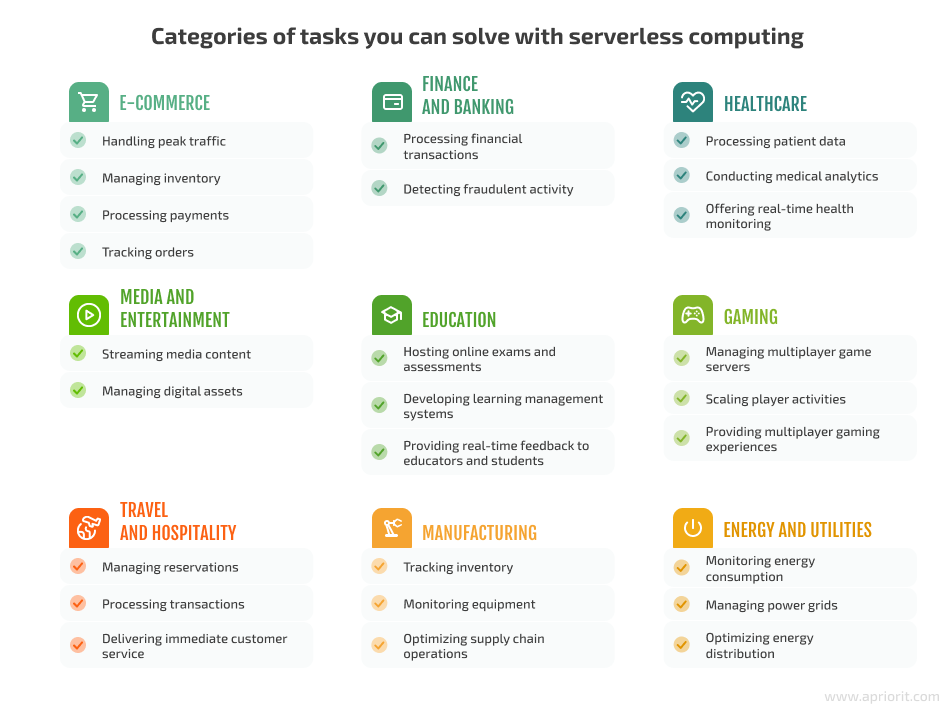
Of course, serverless computing still has some limitations. Next, we explore factors to consider before you decide to switch to this cloud computing model.
Factors to consider before adopting serverless computing
While serverless computing offers numerous benefits to businesses, it’s not a one-size-fits-all solution. It’s crucial for businesses to carefully evaluate their needs, available resources, and long-term objectives before deciding whether to adopt serverless computing.
When is serverless computing not a good fit for your business?
FaaS implementation might not be the right choice in the following cases:

- Predictable workloads. Serverless computing is best suited for handling unpredictable workloads. When your workload is predictable, you might not notice the performance benefits or cost-effectiveness of FaaS.
- Heavy data processing. While serverless computing can handle some data processing tasks, heavy processing workloads may require more powerful computing resources, such as a combination of serverless and traditional computing.
- Need for full control over your infrastructure. You won’t get full control over your resources in the case of serverless computing, as the cloud provider manages the whole infrastructure. Lack of control might be an issue for you if you have specific security or compliance requirements.
- Long-running applications. Serverless functions are designed to be short-lived and stateless, and they’re optimized to run for a few seconds or minutes. This means that serverless computing is not ideal for long-running applications.
- Complex workflows. If you have more than simple and standalone tasks, serverless computing won’t be able to handle the heavy workflow because of the limited runtime and tedious debugging process.
Even when you have considered all the pros and cons of serverless computing and decided that adopting a serverless architecture is right for your business, you still need to consider several challenges that come with implementing this technology.
What are the challenges of serverless computing?
You shouldn’t rush into abandoning your existing setup and moving to a serverless architecture unless you have thought about the following factors:

Let’s explore each of these factors in more detail so you can consider how these limitations may impact your project and make an informed decision.
- Vendor lock-in. It can be difficult to switch to another serverless platform without significant effort and cost. You need to carefully examine all available providers and choose a platform that is reliable and offers a good balance between cost, performance, and flexibility.
- Poor security visibility. This might be a major security issue for some businesses because of the shared responsibility model. You might not see all the security controls that the cloud provider implements. You have to find a platform that offers various security measures such as encryption, identity and access management, audits, and monitoring.
- Challenges integrating with existing systems. This is a major limitation when you have legacy systems that need to be integrated with your new application built on a serverless platform. Consider focusing on a provider that supports the programming languages and tools you are already using. Also, look for platforms with APIs that allow for easy integration with your existing systems.
- Cold start. A cold start is a delay that happens when a new function is invoked for the first time. For instance, it may occasionally take up to ten full seconds to run the first invocation of a JVM-implemented function. Preemptive warming up could be a solution to this problem, but developers may pay penalties for getting their serverless code ready to run. For example, some serverless providers may charge extra fees for keeping functions warm and keep them running.
- Debugging and testing. Since your developers have no control over the provider’s servers, they have limited opportunities for identifying problems and bottlenecks. After a function is executed, it only leaves traces in logs recorded by the serverless platform. In addition, there’s a lack of debugging tools that can operate in serverless environments.
- Limited monitoring and planning of serverless apps. Serverless computing monitoring can be challenging since your provider is the one who manages the whole infrastructure. This leads to limited customization options and a lack of control over performance monitoring, bottleneck identification, and issue diagnostics.
What do you need to plan for monitoring your serverless app?
Even though we’ve mentioned limited monitoring and planning capabilities as a challenge of serverless computing, it’s still possible to overcome this issue. Businesses need to monitor how their serverless apps perform for better performance and cost optimization, timely identification of security threats, and easier troubleshooting.
Monitoring serverless applications includes several steps:

- Identify critical metrics. These metrics are an important part of making sure that your serverless application runs smoothly. They might include response time, error rate, throughput, and resource utilization.
- Choose your monitoring tools. Some cloud providers, such as AWS, Azure, and Google Cloud, offer their own monitoring tools. You can also use third-party instruments that are specifically designed for serverless computing: for example, Thundra, Lumigo, and Epsagon.
- Establish a process for alerting and troubleshooting issues. You might want to set up alerts for critical metrics that you have identified in the first step. You also need to have clear troubleshooting steps and remediation actions for each metric.
- Test your monitoring strategy. This is the step where you make sure that your strategy is efficient. For example, you can create different conditions for your serverless app performance and simulate failure scenarios.
With these steps, you can set up an effective plan for monitoring the reliability and performance of your serverless application.
Conclusion
Serverless computing is a powerful technology that introduces a convenient way for developers to build and deploy applications. As demand for scalable and cost-effective solutions continues to grow, serverless computing can be a great choice for businesses that want to streamline their operations.
By understanding the benefits of this technology, you can make informed decisions about going serverless and leveraging this technology to promote growth and innovation. Apriorit’s cloud development team will gladly assist you with building a cost-effective yet high-quality and time-efficient serverless solution.
Contact us so we can find the best approach to implementing a serverless architecture for your solution!



